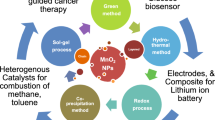Abstract
A new method called ultrasonic-assisted membrane reaction (UAMR) was reported for the fabrication of ceria-zirconia solid solution. A series of ceria-zirconia solid solutions with different Ce/Zr molar ratios were prepared by the UAMR method and characterized by X-ray diffraction (XRD), N2 adsorption, hydrogen temperature-programmed reduction (H2-TPR), scanning electron microscope (SEM), and transmission electron microscopy (TEM) techniques. The UAMR method proved to be superior, especially when the Ce/Zr molar ratio was lower than 1, in fabricating ceria-zirconia solid solutions with large BET surface area, high oxygen storage capacity (OSC), and low reduction temperature.
Similar content being viewed by others
References
Fornasiero P, Balducci G, Di Monte R, Kašpar J. Modification of the Redox Behaviour of CeO2 Induced by Structural Doping with ZrO2. Journal of Catalysis, 1996, 164(1): 173–183
Balducci G, Fornasiero P, Di Monte, R. An unusual promotion of the redox behavior of CeO2-ZrO2 solid solutions upon sintering at high temperatures. Catalysis Letter, 1995, 33: 193–200
Zhang Q, Wei J, Shen MQ, Wang, J. Effect of different mixing ways in palladium/ceria-zirconia/alumina preparation on partial oxidation of methane. Journal of Rare Earths, 2008, 26(5): 700–704
Escritori J C, Dantas S C, Soares R R, Hori C E. Methane autothermal reforming on nickel-ceria-zirconia based catalysts. Catalysis Communications, 2009, 10(7): 1090–1094
Reddy B M, Thrimurthulu G, Saikia P, Bharali P. Silica supported ceria and ceria-zirconia nanocomposite oxides for selective dehydration of 4-methylpentan-2-ol. Journal of Molecular Catalysis: A, Chemical, 2007, 275: 167–173
Radhakrishnan R, Willigan R R, Dardas Z, Vanderspurt T H. Water gas shift activity and kinetics of Pt/Re catalysts supported on ceria-zirconia oxides. Applied Catalysis B: Environmental, 2006, 66(20): 23–28
Djurcic B, McGarry D, Pickering S. The preparation of ultrafine ceria-stabilized zirconia particles coated with yttria. Journal of Materials Science Letters, 1993, 12(16): 1320–1323
Deptula A, Carewska M, Olczak T, Lada W, Croce F. Sintering of ZrO2-CeO2 Spherical Powders Prepared by a Water Extraction Variant of the Sol-Gel Process. Journal of the Electrochemical Society, 1993, 140(8): 2294–2297
Potdar H S, Deshpande S B, Deshpande A S, Gokale S P, Khollam Y B, Patil A J, Date S K. Preparation of ceria-zirconia (Ce0.75Zr0.25O2) powders by microwave-hydrothermal (MH) route. Materials Chemistry and Physics, 2002, 74(1): 306–312
Maschio S, Piras A, Schmid C, Lucchini E. Effects of attrition milling on precursors of Al2O3 and 12Ce-TZP powders. Journal of European Ceramic Society, 2001, 21: 589–594
Teng M, Luo L, Yang X. Synthesis of mesoporous Ce1-x ZrxO2 (x = 0.2–0.5) and catalytic properties of CuO based catalysts. Micro-porous and Mesoporous Materials, 2009, 119(1): 158–164
Dobrosz-Gómez I, Kocemba I, Rynkowski J M. Au/Ce1-x ZrxO2 as effective catalysts for low-temperature CO oxidation. Applied Catalysis B: Environmental, 2008, 83(23): 240–255
Cabanas A, Darr J A, Lester E, Poliakoff M. Continuous hydrothermal synthesis of inorganic materials in a near critical water flow reactor; the one-step synthesis of nano-particulate Ce1-x ZrxO2 (x =0–1) solid solutions. Journal of Materials Chemistry, 2001, 11: 561–568
Mai H X, Sun L D, Zhang Y W, Si R, Feng W, Liu H C, Y C H. Shape-selective synthesis and oxygen storage behavior of ceria nanopolyhedra, nanorods and nanocubes. Journal of Physical Chemistry B, 2005, 109(51): 24380–24385
Zhai S, Wei W, Wu D, Sun Y. Synthesis, characterization and catalytic activities of mesoporous AlMSU-X with wormhole-like framework structure. Catalysis Letter, 2003, 89: 261–267
Madier Y, Descorme C, Le Govic A M, Duprez D. Oxygen Mobility in CeO2 and CexZr(1-x)O2 Compounds: Study by CO Transient Oxidation and 18O/16O Isotopic Exchange. Journal of Physical Chemistry B, 1999,103 (50): 10999–11006
Parvulescu V, Anastasescu C, Su B L. Bimetallic Ru-(Cr, Ni, or Cu) and La-(Co or Mn) incorporated MCM-41 molecular sieves as catalysts for oxidation of aromatic hydrocarbons. Journal of Molecular Catalysis A: Chemical, 2004, 211(15): 143–148
Wei Z L, Li H M, Zhang X Y, Yan S H, Lv Z, Chen Y Q, Gong MC. Preparation and property investigation of CeO2-ZrO2-Al2O3 oxygen-storage compounds. Journal of Alloy and Compounds, 2008, 455: 322–326
Kim J R, Myeong W J, Ihm S K. Characteristics in oxygen storage capacity of ceria-zirconia mixed oxide prepared by continuous hydrothermal synthesis in supercritical water. Applied Catalysis B: Environmental, 2007, 71: 57–63
Kašpar J, Fornasiero P, Graziani M. Use of CeO2-based oxides in the three-way catalysis. Catalysis Today, 1999, 50: 285–298
Kašpar J, Fornasiero, P, Hickey N. Automotive catalytic converters: current status and some perspectives. Catalysis Today, 2003, 77: 419–449
Wang X H, Lu G Z, Guo Y, Xue Y Y, Jiang L Z, Guo Y L, Zhang Z G. Structure, thermal-stability and reducibility of Si-doped Ce-Zr-O solid solution. Catalysis Today, 2007, 126: 412–419
Yao H C, Yu Yao Y F. Ceria in automotive exhaust catalysts: I. Oxygen storage. Journal of Catalysis, 1984, 86(2): 254–265
Johnson M F L, Mooi J. Cerium dioxide crystallite sizes by temperature-programmed reduction. Journal of Catalysis, 1987, 103: 502–505
Larese C, Granados M L, Mariscal R, Fierro J L G, Lambrou P S, Efstathiou A M. The effect of calcination temperature on the oxygen storage and release properties of CeO2 and Ce-Zr-O metal oxides modified by phosphorus incorporation. Applied Catalysis B: Environmental, 2005, 59: 13–25
Dong F, Suda A, Tanabe T, Nagai Y, Sobukawa H, Shinjoh H, Sugiura M, Descorme C, Duprez D. Dynamic oxygen mobility and a new insight into the role of Zr atoms in three-way catalysts of Pt/CeO2-ZrO2. Catalysis Today, 2004, 93–95: 827–832
Kašpar J, Fornasiero P. Nanostructured materials for advanced automotive de-pollution catalysts. Journal of Solid State Chemistry, 2003, 171: 19–29
Author information
Authors and Affiliations
Corresponding author
Rights and permissions
About this article
Cite this article
Meng, L., Liu, L., Zi, X. et al. Preparation of ceria-zirconia solid solution with enhanced oxygen storage capacity and redox performance. Front. Environ. Sci. Eng. China 4, 164–171 (2010). https://doi.org/10.1007/s11783-010-0019-2
Received:
Accepted:
Published:
Issue Date:
DOI: https://doi.org/10.1007/s11783-010-0019-2




